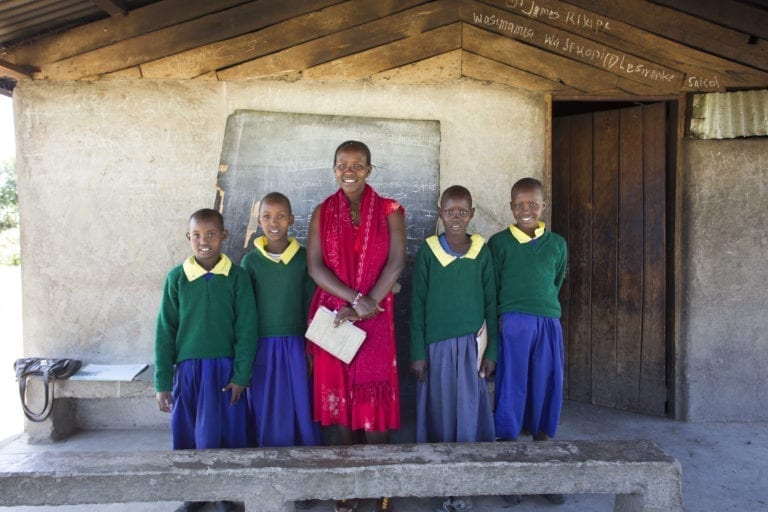Understanding School-Related Gender-Based Violence: Building the Evidence Base - Highlights from Secondary Analyses of VACS in Five Different Countries
This blog is part of the Committing to Change: Girls’ EiE from Charlevoix to COVID-19 blog series. This blog is courtesy of Together for Girls, originally published here.
Education is a fundamental human right

Every child around the world deserves the opportunity to learn. Education is a basic human right and a necessary pathway to ending extreme poverty. We know that equitable, quality education has an immense power to transform the lives of individuals, communities, and nations.
Unfortunately, our data shows that across the globe students do not always attend school in a safe setting, and many experience unacceptably high rates of school-related gender-based violence (SRGBV). UNESCO and UN Women’s Global Guidance to Address SRGBV define SRGBV as “any act or threat of sexual, physical, or psychological violence occurring in and around schools, perpetrated as a result of gender norms.” This can include teacher-perpetrated abuse, such as corporal punishment or sexual coercion. It can also include peer-perpetrated abuse, including physical violence, bullying, or discrimination.
Studying school-related gender-based violence
There are large gaps in global research about the complexities and nuances of SRGBV. In response, USAID’s Higher Education Solutions Network (HESN) supported AidData, a research lab at William & Mary, and Together for Girls to conduct secondary analyses of the Violence Against Children & Youth Surveys (VACS) data to identify the prevalence of SRGBV, as well as details on violence perpetration, victimization risk, and post violence behaviors–including schools absenteeism, disclosure, service-seeking, and service-receiving–in selected countries.
This project is an exciting opportunity to unpack the national-level data available in the VACS to bolster our understanding of SRGBV. By better understanding the complexities and nuances of violence in schools, our project’s goal is to create a framework for governments and other actors to better prevent and address violence in school.
Guided by data, communities can enact evidence-based policies and engage in actions that prevent violence and create a safer environment for all students. Read on for key highlights from the project and to learn more about what the VACS can tell us about SRGBV.
What topics do the secondary analyses cover?
The VACS are led by national governments with technical support by CDC as part of the Together for Girls partnership. The national-level surveys measure the prevalence, past 12-month incidence, and circumstances surrounding violence in childhood and young adulthood (before age 24). For more information about the VACS, visit our About the VACS page.
While the VACS tell us more about violence in schools than any other widely applied survey, they are comprehensive surveys of violence, not explicitly focused on educational settings or SRGBV. An important limitation of this research is that these SRGBV prevalence estimates may not be fully representative of the spectrum of forms of SRGBV experienced.
The secondary analyses considered five VACS data sets (from Honduras, Malawi, Nigeria, Uganda, and Zambia.), utilizing cross-sectional regression analysis techniques. The U.S. Centers for Disease Control and Prevention (CDC) provided technical consultation on the project. Key research questions include:
- What is the national prevalence of SRGBV?
- Do boys and girls experience similar rates of SRGBV?
- Are boys or girls more likely to experience one form of SRGBV?
- How does SRGBV affect rates of school absenteeism for boys and girls?
- What are patterns for disclosing incidents of SRGBV and seeking or receiving services for boys and girls?
What did the analyses tell us about SRGBV?

What are the key takeaways and next steps from this research?
Violence in school settings is often gendered.

Looking at the data, it’s evident that violence in school settings is gendered. The VACS findings specific to school settings and school-related perpetrators reinforce our understanding that violence in school settings is often gendered.
For example, male students are consistently more likely to perpetrate and report experiencing physical violence, while female students report experiencing higher rates of sexual violence. We also see notable trends among teacher-perpetrated violence; students who experienced teacher-perpetrated violence are more likely to report their perpetrator was male than was female, but there is variation in whether more male or female students report experiencing violence.
This indicates a need for more qualitative, contextual information to understand why these variations exist. We need more and better quantitative and qualitative data that capture the array of SRGBV experiences by students to guide policy- and decision-makers, practitioners, and advocates.
SRGBV prevention requires a multi-pronged approach.
Our research also shows that SRGBV prevention requires a multi-pronged approach, including a number of different stakeholders, from governments to teachers unions to school administrators and faculty to parents’ associations to students to civil society. This should include:
- The development and implementation of strong legal frameworks;
- Evidence-based, locally-grounded, and integrated interventions to create safe and accountable school environments;
- A focus on changing social norms around gender and the acceptability of violence;
- Recognition of students’ agency and their active inclusion in solutions.
While our research reinforces that school environments can enable violence, they also can serve as important protective spaces for children, acting as an arena for broader social change to end violence both inside and outside of the classroom.
Using data as their guide, communities can reimagine the relationship between violence, students, and schools and create a safer learning environment for all students.
To learn more about SRGBV, visit our Schools page where you’ll find facts sheets, partner resources, and examples of evidence-based interventions to prevent SRGBV.
The views expressed in this blog are the author's own.



